Charles E W Bean, Diaries, AWM38 3DRL 606/267/1 - 1914 - 1915 - Part 8

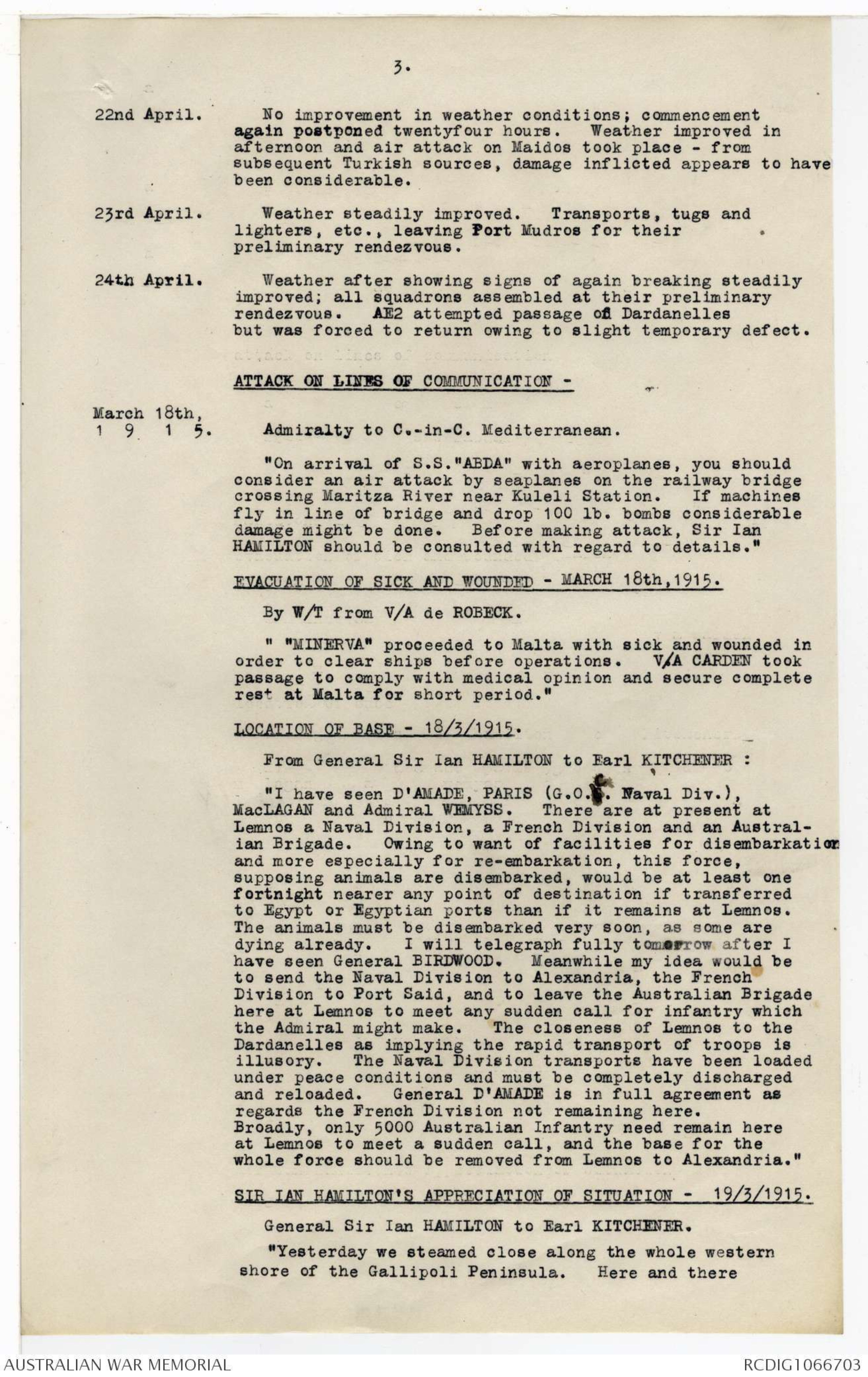
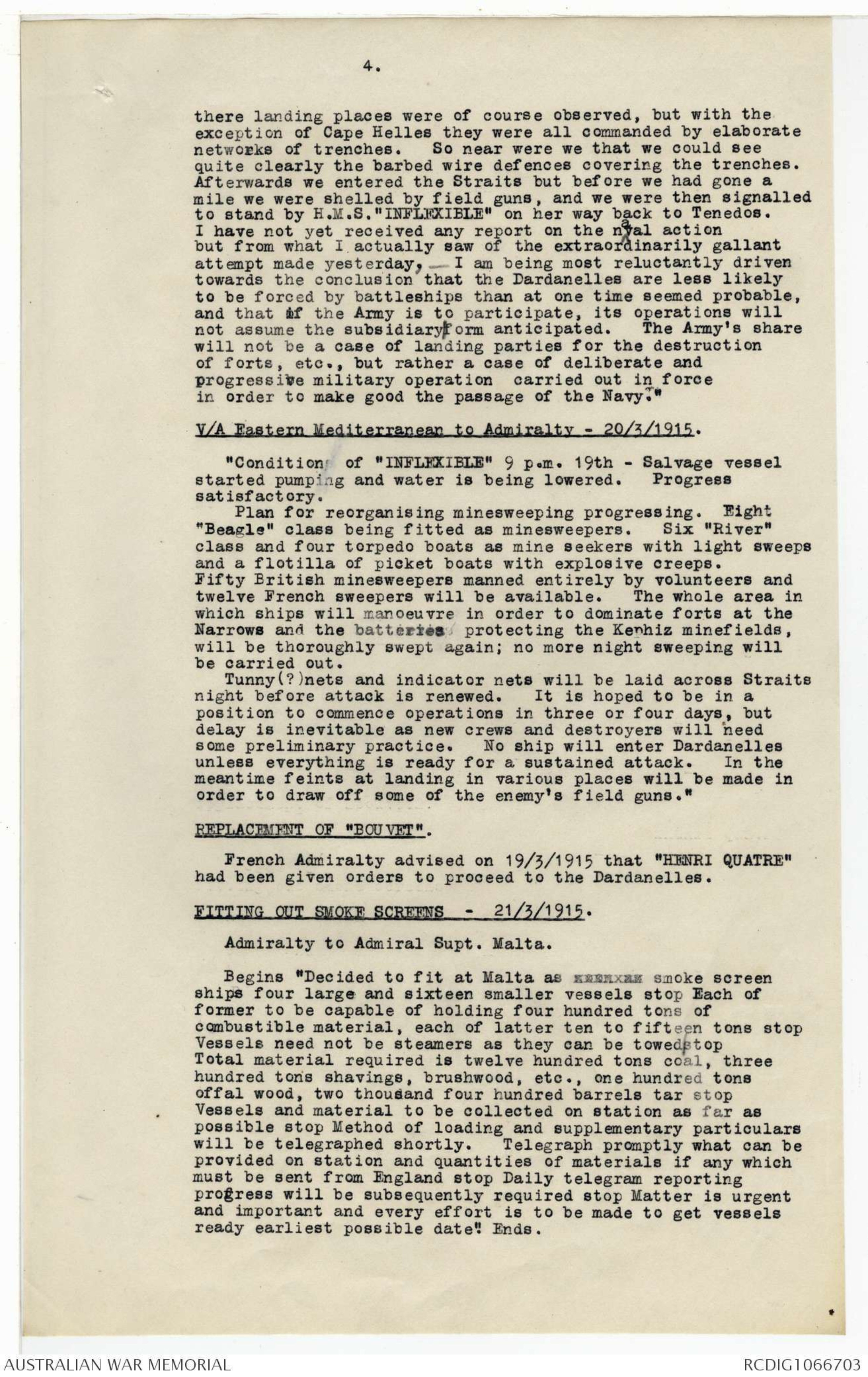
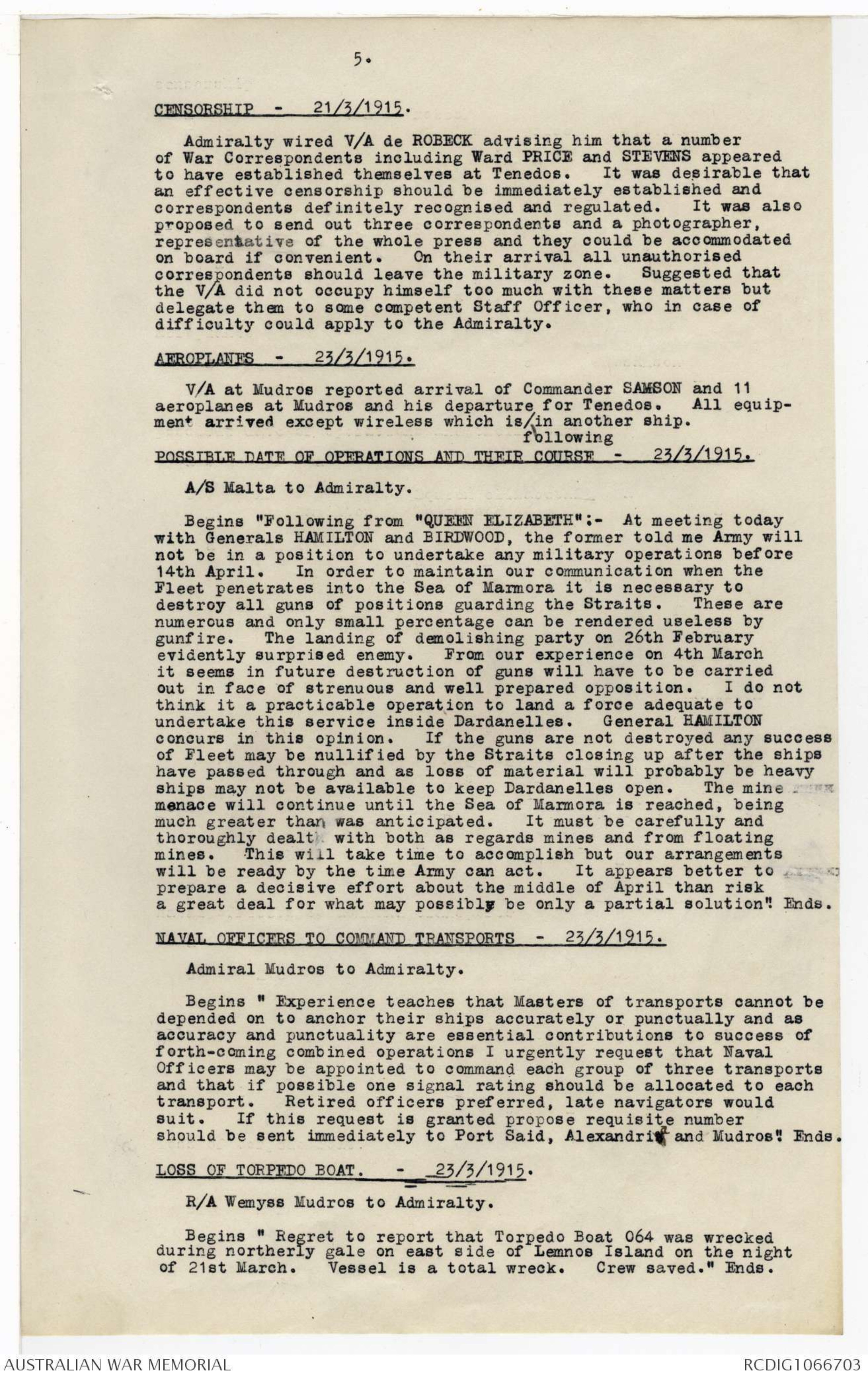
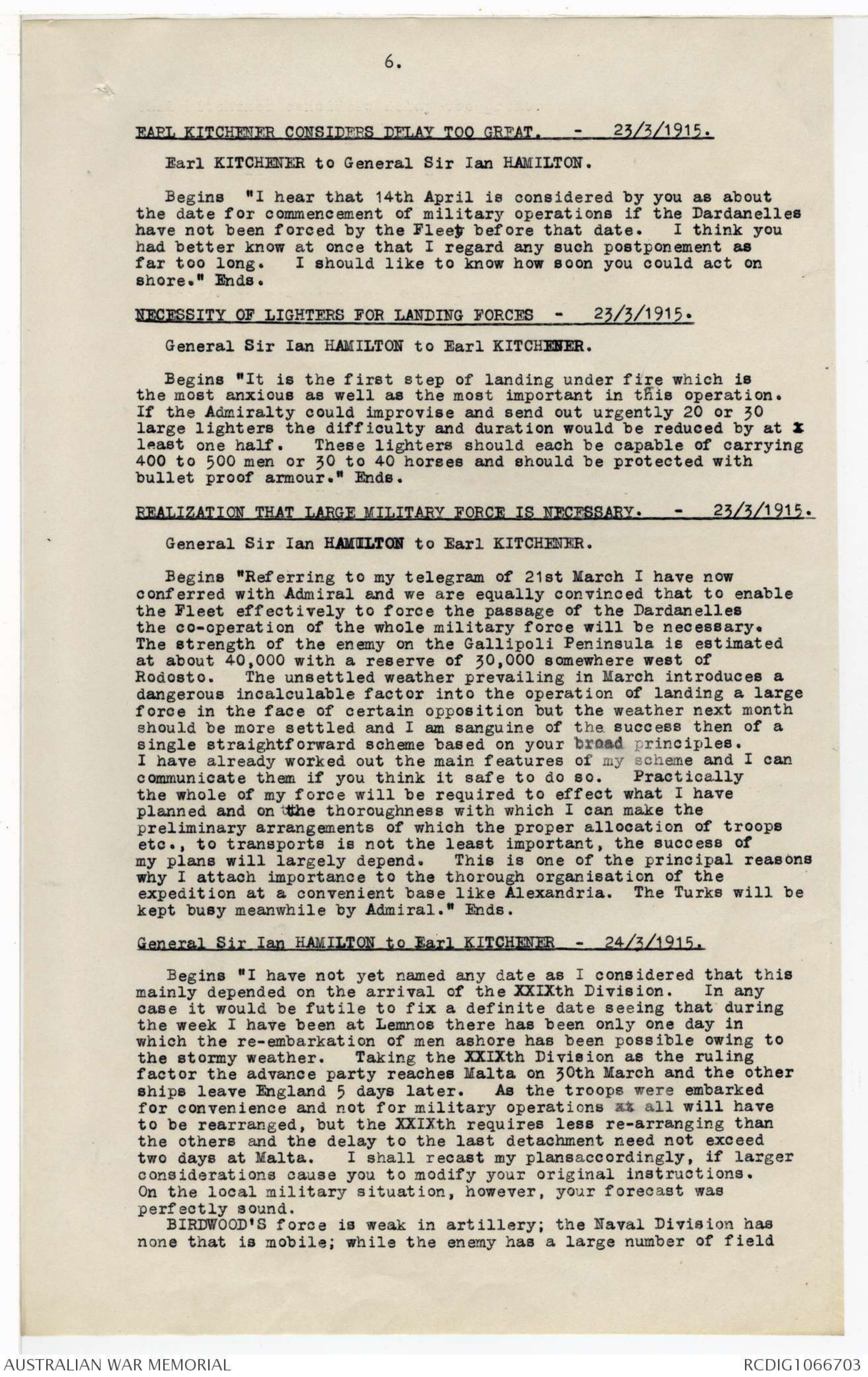

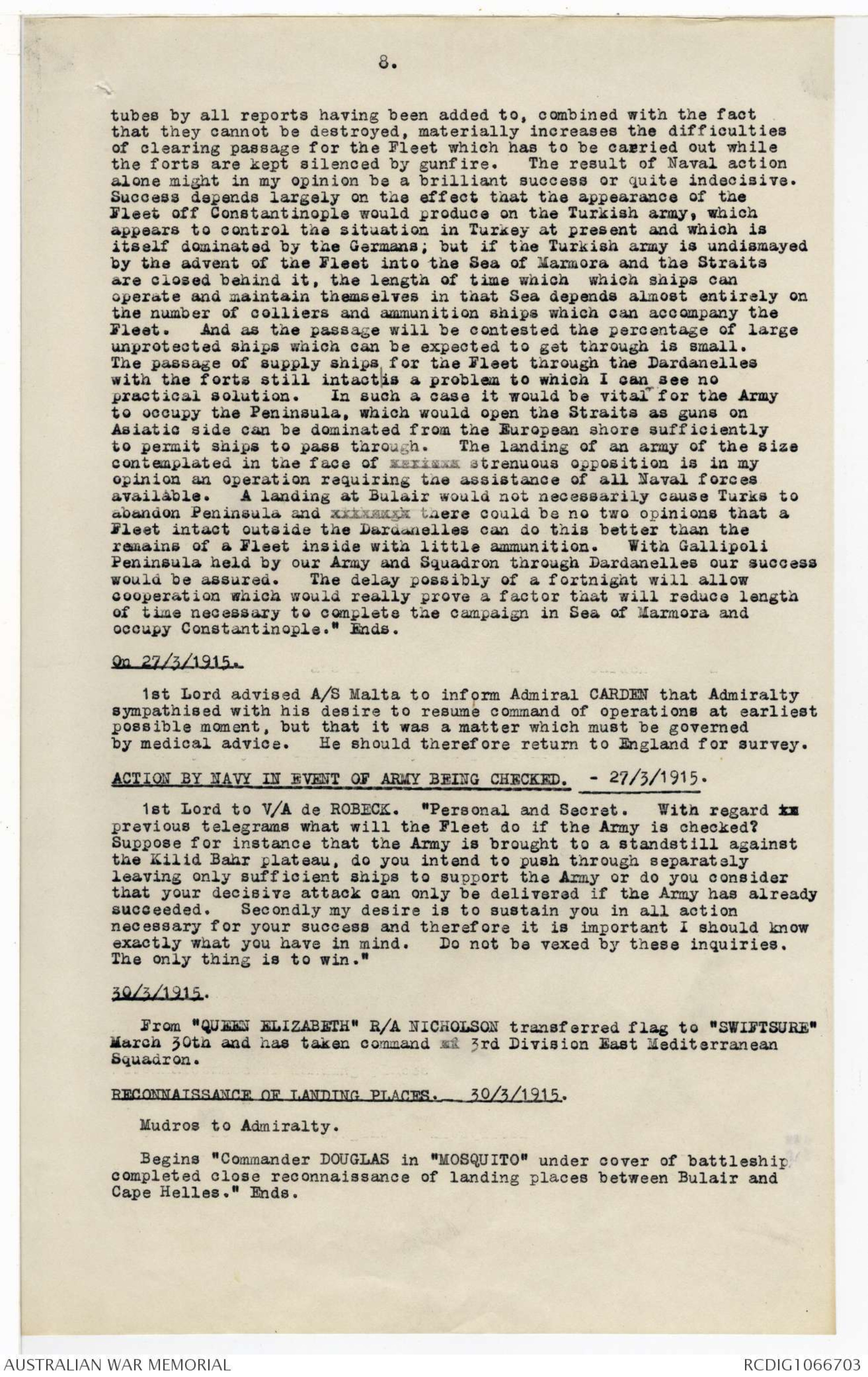

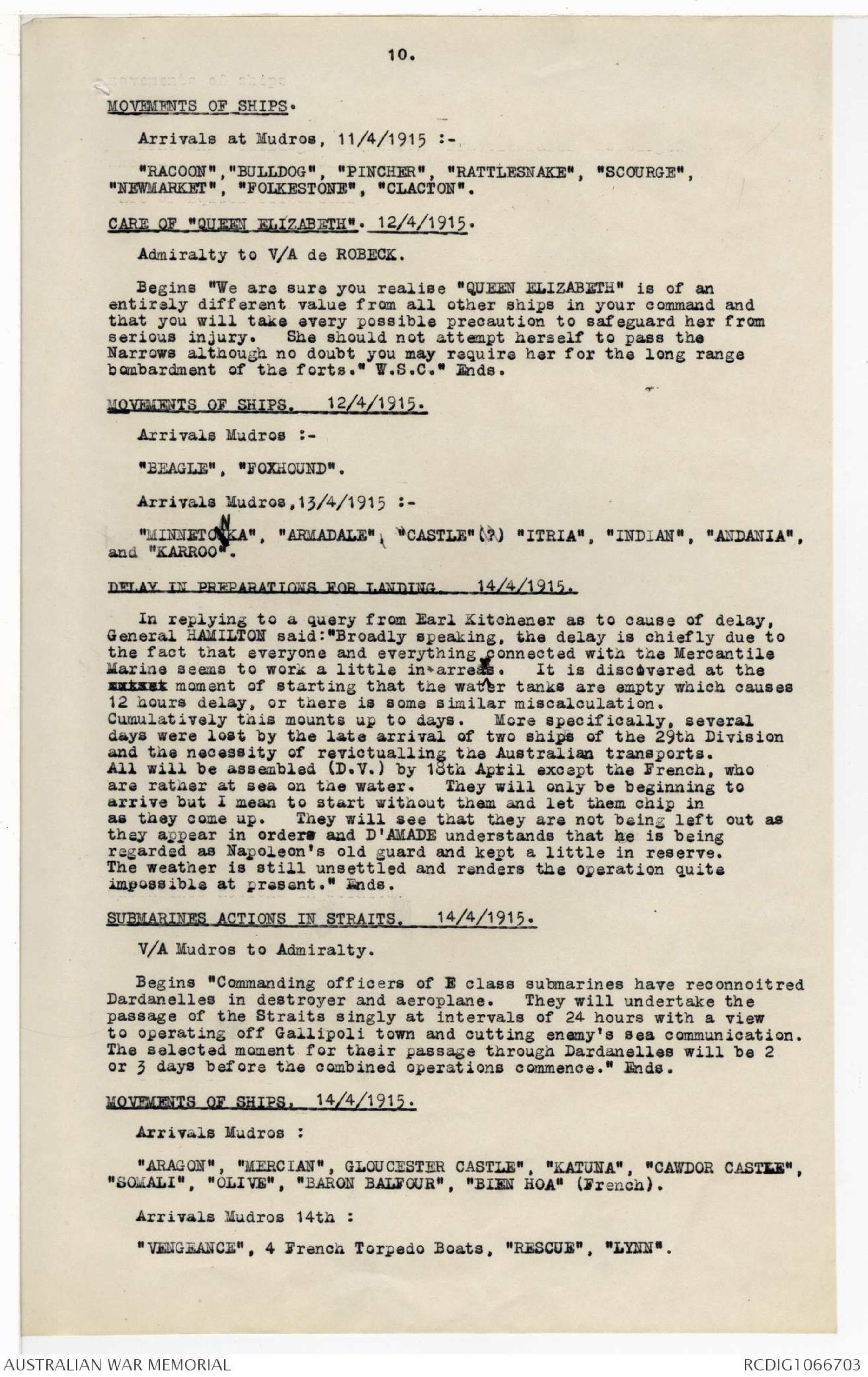
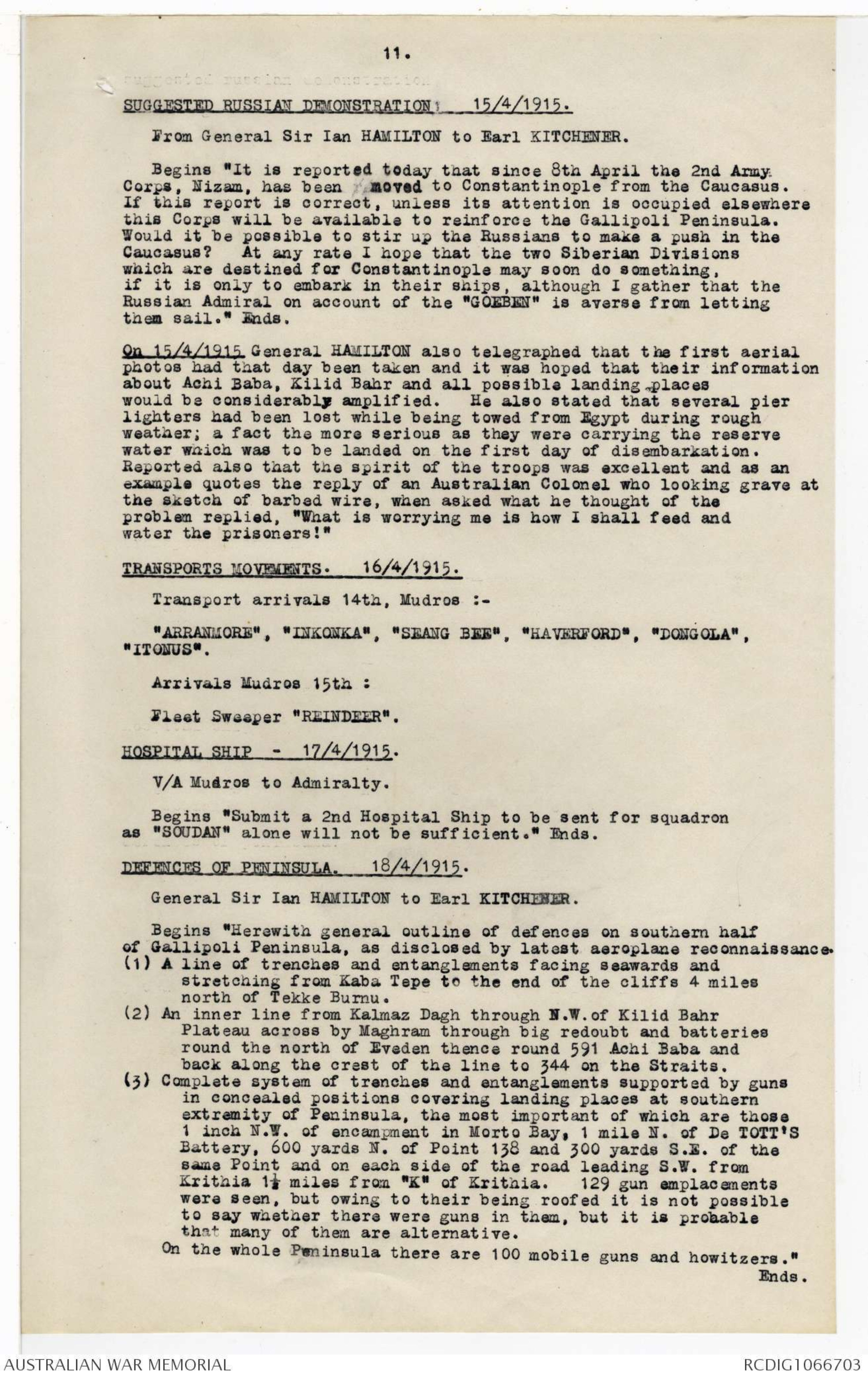
2
jumped overboard. Fiftyone men were drowned including
some ship's officers. Torpedo boat subsequently chased
in by "KENNET" and "JED". On being cut off by "WEAR" in
Khios Channel, ran herself aground in Kalamuti Bay. Crew
were arrested by local authorities and interned.
"DARTMOUTH" and destroyers sent to convoy remainder of
transports through dangerous area. This necessitating
abandonment of sweeping operations by destroyers.
Seaplanes attacked store depots and ships in port at
Gallipoli and observed several gun emplacements.
Aeroplanes attacked troops near Maidos. Additional destroyer
sent to Smyrna patrol.
17th April. Morning of 17th. Submarine E15 attempted passage of
Dardanelles with the object of operating in Sea of Marmora
and cutting communication by sea with Gallipoli Peninsula.
Arrangements made for aeroplane to follow the passage and
drop bombs to create diversion. Aeroplane returned 10 a.m.
reported submarine aground south of Kephiz light with enemy
torpedo boat alongside. Submarine B6 was sent up to torpedo
the wreck; she fired one torpedo, being under fire herself
the torpedo did not hit, but a tug alongside E15 was observed
to sink by H.M.S, "VENGEANCE". Torpedo from B6 was
subsequently recovered. On night of 17th/18th "SCORPION'
and "GRAMPUS" attacked the wreck, the former getting within
1000 yards of supposed position. However by clever
manipulation of searchlights enemy hid submarine and destroyers
were forced to retire under heavy fire. Seaplane
reconnoitring Smyrna reported only two torpedo boats in
the harbour.
18th April. Enemy's aeroplane attacked Tenedos aerodrome unsuccessfully.
Submarine B11 reconnoitred wreck of E15 at dawn but fog
prevented wreck being seen. In afternoon "TRIUMPH" and
"MAJESTIC" attacked wreck with aeroplane spotting, no hits
obtained. Aeroplane with bombs prevented enemy approaching
E15. At night picket boats from "TRIUMPH" and "MAJESTIC"
manned by volunteer crews successfully attacked and torpedoed
E15 rendering her useless for service with the enemy.
"MINERVA" reported wireless station stated to be at Chesme
is actually at Latyato and not within range of the sea.
19th April. Submarine B6 reconnoitred wreck of E15 and reported her
heeled over on starboard side, conning tower probably resting
on bottom. B6 narrowly missed being wrecked near E15, she
was caught by the strong current and carried onshore, but by
skilful handling managed to get off though fire was opened
on her. Her conning tower was exposed for 3½ minutes.
At a meeting of all the principal officers it was decided
to commence operations on Friday 23rd April. Agent returned
from Budrum; reported no oil or rifles landed there, his
information being quite conclusive. Raid on Budrum in
consequence postponed by order of Admiralty. "BACCHANTE"
and "TALBOT" assisted by balloon kite and aeroplane
spotting attacked encampments at dawn and subsequently
field guns in neighbourhood of Gaba Tepe. Spotting from
balloon kite very well reported on. Battleships on patrol
harassing enemy on both shores.
20th April Preparations for landing on 23rd being completed. Ships
ready to leave for preliminary rendezvous.
21st April. Strong N.E. wind. Commencement of operations postponed
for twenty four hours. Yacht "TRIAD" armed with two
12 pounders sent to relieve "MINERVA" on Smyrna patrol.
Bomb attack on Maidos, headquarters of Turkish Army, ordered
for first favourable day.
3
22nd April. No improvement in weather conditions; commencement
again postponed twentyfour hours. Weather improved in
afternoon and air attack on Maidos took place - from
subsequent Turkish sources, damage inflicted appears to have
been considerable.
23rd April. Weather steadily improved. Transports, tugs and
lighters, etc., leaving Port Mudros for their
preliminary rendezvous.
24th April. Weather after showing signs of again breaking steadily
improved; all squadrons assembled at their preliminary
rendezvous. AE2 attempted passage of Dardanelles
but was forced to return owing to slight temporary defect.
ATTACK ON LINES OF COMMUNICATION -
March 18th,
1915 Admiralty to C.-in-C. Mediterranean.
"On arrival of S.S."ABDA" with aeroplanes, you should
consider an air attack by seaplanes on the railway bridge
crossing Maritza River near Kuleli Station. If machines
fly in line of bridge and drop 100 lb. bombs considerable
damage might be done. Before making attack, Sir Ian
HAMILTON should be consulted with regard to details."
EVACUATION OF SICK AND WOUNDED - MARCH 18th, 1915.
By W/T from V/A de ROBECK.
" "MINERVA" proceeded to Malta with sick and wounded in
order to clear ships before operations. V/A CARDEN took
passage to comply with medical opinion and secure complete
rest at Malta for short period."
LOCATION OF BASE - 18/3/1915.
From General Sir Ian HAMILTON to Earl KITCHENER:
"I have seen D'AMADE, PARIS (G.O X C.. Naval Div.)
MacLAGAN and Admiral WEMYSS. There are at present at
Lemnos a Naval Division, a French Division and an Australian
Brigade. Owing to want of facilities for disembarkation
and more especially for re-embarkation, this force,
supposing animals are disembarked, would be at least one
fortnight nearer any point of destination if transferred
to Egypt or Egyptian ports than if it remains at Lemnos.
The animals must be disembarked very soon, as some are
dying already. I will telegraph fully tomorrow after I
have seen General BIRDWOOD. Meanwhile my idea would be
to send the Naval Division to Alexandria, the French
Division to Port Said, and to leave the Australian Brigade
here at Lemnos to meet any sudden call for infantry which
the Admiral might make. The closeness of Lemnos to the
Dardanelles as implying the rapid transport of troops is
illusory. The Naval Division transports have been loaded
under peace conditions and must be completely discharged
and reloaded. General D'AMADE is in full agreement as
regards the French Division not remaining here.
Broadly, only 5000 Australian Infantry need remain here
at Lemnos to meet a sudden call, and the base for the
whole force should be removed from Lemnos to Alexandria."
SIR IAN HAMILTON'S APPPECIATION OF SITUATION - 19/3/1915.
General Sir Ian HAMILTON to Earl KITCHENER.
"Yesterday we steamed close along the whole western
shore of the Gallipoli Peninsula. Here and there
4
there landing places were of course observed, but with the
exception of Cape Helles they were all commanded by elaborate
networks of trenches. So near were we that we could see
quite clearly the barbed wire defences covering the trenches.
Afterwards we entered the Straits but before we had gone a
mile we were shelled by field guns, and we were then signalled
to stand by H.M.S."INFLEXIBLE" on her way back to Tenedos.
I have not yet received any report on the n^aval action
but from what I actually saw of the extraordinarily gallant
attempt made yesterday, - I am being most reluctantly driven
towards the conclusion that the Dardanelles are less likely
to be forced by battleships than at one time seemed probable,
and that if the Army is to participate, its operations will
not assume the subsidiary/form anticipated. The Army's share
will not be a case of landing parties for the destruction
of forts, etc., but rather a case of deliberate and
progressive military operation carried out in force
in order to make good the passage of the Navy."
V/A Eastern Mediterranean to Admiralty - 20/3/1915.
"Condition of "INFLEXIBLE" 9 p.m. 19th - Salvage vessel
started pumping and water is being lowered. Progress
satisfactory.
Plan for reorganising minesweeping progressing. Eight
"Beagle" class being fitted as minesweepers. Six "River"
class and four torpedo boats as mine seekers with light sweeps
and a flotilla of picket boats with explosive creeps.
Fifty British minesweepers manned entirely by volunteers and
twelve French sweepers will be available. The whole area in
which ships will manoeuvre in order to dominate forts at the
Narrows and the batteries protecting the Kephiz minefields,
will be thoroughly swept again; no more night sweeping will
be carried out.
Tunny (?) nets and indicator nets will be laid across Straits
night before attack is renewed. It is hoped to be in a
position to commence operations in three or four days, but
delay is inevitable as new crews and destroyers will need
some preliminary practice. No ship will enter Dardanelles
unless everything is ready for a sustained attack. In the
meantime feints at landing in various places will be made in
order to draw off some of the enemy's field guns."
REPLACEMENT OF "BOUVET".
French Admiralty advised on 19/3/1915 that "HENRI QUATRE"
had been given orders to proceed to the Dardanelles.
FITTING OUT SMOKE SCREENS - 21/3/1915.
Admiralty to Admiral Supt. Malta.
Begins "Decided to fit at Malta as xxxxxxx smoke screen
ships four large and sixteen smaller vessels stop Each of
former to be capable of holding four hundred tons of
combustible material, each of latter ten to fifteen tons stop
Vessels need not be steamers as they can be towed/stop
Total material required is twelve hundred tons coal, three
hundred tons shavings, brushwood, etc., one hundred tons
offal wood, two thousand four hundred barrels tar stop
Vessels and material to be collected on station as far as
possible stop Method of loading and supplementary particulars
will be telegraphed shortly. Telegraph promptly what can be
provided on station and quantities of materials if any which
must be sent from England stop Daily telegram reporting
progress will be subsequently required stop Matter is urgent
and important and every effort is to be made to get vessels
ready earliest possible date". Ends.
5
CENSORSHIP - 21/3/1915.
Admiralty wired V/A de ROBECK advising him that a number
of War Correspondents including Ward PRICE and STEVENS appeared
to have established themselves at Tenedos. It was desirable that
an effective censorship should be immediately established and
correspondents definitely recognised and regulated. It was also
proposed to send out three correspondents and a photographer
representative of the whole press and they could be accommodated
on board if convenient. On their arrival all unauthorised
correspondents should leave the military zone. Suggested that
the V/A did not occupy himself too much with these matters but
delegate them to some competent Staff Officer, who in case of
difficulty could apply to the Admiralty.
AEROPLANES - 23/3/1915.
V/A at Mudros reported arrival of Commander SAMSON and 11
aeroplanes at Mudros and his departure for Tenedos. All equipment
arrived except wireless which is/ ^following in another ship.
POSSIBLE DATE OF OPERATIONS AND THEIR COURSE - 23/3/1915.
A/S Malta to Admiralty.
Begins "Following from "QUEEN ELIZABETH":- At meeting today
with Generals HAMILTON and BIRDWOOD, the former told me Army will
not be in a position to undertake any military operations before
14th April. In order to maintain our communication when the
Fleet penetrates into the Sea of Marmora it is necessary to
destroy all guns of positions guarding the Straits. These are
numerous and only small percentage can be rendered useless by
gunfire. The landing of demolishing party on 26th February
evidently surprised enemy. From our experience on 4th March
it seems in future destruction of guns will have to be carried
out in face of strenuous and well prepared opposition. I do not
think it a practicable operation to land a force adequate to
undertake this service inside Dardanelles. General HAMILTON
concurs in this opinion. If the guns are not destroyed any success
of Fleet may be nullified by the Straits closing up after the ships
have passed through and as loss of material will probably be heavy
ships may not be available to keep Dardanelles open. The mine
menace will continue until the Sea of Marmora is reached, being
much greater than was anticipated. It must be carefully and
thoroughly dealt with both as regards mines and from floating
mines. This will take time to accomplish but our arrangements
will be ready by the time Army can act. It appears better to
prepare a decisive effort about the middle of April than risk
a great deal for what may possibly be only a partial solution." Ends.
NAVAL OFFICERS TO COMMAND TRANSPORTS - 23/3/1915.
Admiral Mudros to Admiralty.
Begins “Experience teaches that Masters of transports cannot be
depended on to anchor their ships accurately or punctually and as
accuracy and punctuality are essential contributions to success of
forth-coming combined operations I urgently request that Naval
Officers may be appointed to command each group of three transports
and that if possible one signal rating should be allocated to each
transport. Retired officers preferred, late navigators would
suit. If this request is granted propose requisite number
should be sent immediately to Port Said, Alexandria and Mudros." Ends.
LOSS OF TORPEDO BOAT. - 23/3/1915.
R/A Wemyss Mudros to Admiralty.
Begins " Regret to report that Torpedo Boat 064 was wrecked
during northerly gale on east side of Lemnos Island on the night
of 21st March. Vessel is a total wreck. Crew saved." Ends.
6
EARL KITCHENER CONSIDERS DELAY TOO GREAT. - 23/3/1915.
Earl KITCHENER to General Sir Ian HAMILTON.
Begins "I hear that 14th April is considered by you as about
the date for commencement of military operations if the Dardanelles
have not been forced by the Fleet before that date. I think you
had better know at once that I regard any such postponement as
far too long. I should like to know how soon you could act on
shore." Ends.
NECESSITY OF LIGHTERS FOR LANDING FORCES - 23/3/1915.
General Sir Ian HAMILTON to Earl KITCHENER.
Begins "It is the first step of landing under fire which is
the most anxious as well as the most important in this operation.
If the Admiralty could improvise and send out urgently 20 or 30
large lighters the difficulty and duration would be reduced by at X
least one half. These lighters should each be capable of carrying
400 to 500 men or 30 to 40 horses and should be protected with
bullet proof armour." Ends.
REALIZATION THAT LARGE MILITARY IS NECESSARY. - 23/3/1915.
General Sir lan HAMILTON to Earl KITCHENER.
Begins "Referring to my telegram of 21st March I have now
conferred with Admiral and we are equally convinced that to enable
the Fleet effectively to force the passage of the Dardanelles
the co-operation of the whole military force will be necessary.
The strength of the enemy on the Gallipoli Peninsula is estimated
at about 40,000 with a reserve of 30,000 somewhere west of
Rodosto. The unsettled weather prevailing in March introduces a
dangerous incalculable factor into the operation of landing a large
force in the face of certain opposition but the weather next month
should be more settled and I am sanguine of the success then of a
single straightforward scheme based on your broad principles.
I have already worked out the main features of my scheme and I can
communicate them if you think it safe to do so. Practically
the whole of my force will be required to effect what I have
planned and on the thoroughness with which I can make the
preliminary arrangements of which the proper allocation of troops
etc., to transports is not the least important, the success of
my plans will largely depend. This is one of the principal reasons
why I attach importance to the thorough organisation of the
expedition at a convenient base like Alexandria. The Turks will be
kept busy meanwhile by Admiral." Ends.
General Sir Ian HAMILTON to Earl KITCHENER - 24/3/1915.
Begins "I have not yet named any date as I considered that this
mainly depended on the arrival of the XXIXth Division. In any
case it would be futile to fix a definite date seeing that during
the week I have been at Lemnos there has been only one day in
which the re-embarkation of men ashore has been possible owing to
the stormy weather. Taking the XXIXth Division as the ruling
factor the advance party reaches Malta on 30th March and the other
ships leave England 5 days later. As the troops were embarked
for convenience and not for military operations xx all will have
to be rearranged, but the XXIXth requires less re-arranging than
the others and the delay to the last detachment need not exceed
two days at Malta. I shall recast my plansaccordingly, if larger
considerations cause you to modify your original instructions.
On the local military situation, however, your forecast was
perfectly sound.
BIRDWOOD'S force is weak in artillery; the Naval Division has
none that is mobile; while the enemy has a large number of field
7
field guns and howitzers in concealed positions which cannot be
dealt with by fire from ships. The guns of the XXIXth Division
are, therefore, very desirable. I hope in any case to complete
BIRDWOOD'S New Zealand Brigade Division by a brigade of Ghurkas
who would be admirably suited to the terrain, in place of the
Mounted Brigade, which for the present would be left in Egypt.
I am starting for Alexandria. The Admiral, whose confidence in the
Navy seems to have been raised even higher by recent events, and
who is a thruster if ever there was one, is in agreement with
this telegram." Ends.
DECISION OF de ROBECK THAT TIME IS RIPE FOR COMBINED ATTACK. 27/3/15.
V/A de ROBECK to Admiralty.
Begins "First Lord. Secret. I do not consider check on 18th
was decisive and am still of opinion that a portion of Fleet would
succeed in entering Sea of Marmora. Nothing has occurred since 21st
to alter my intention to press enemy hard until I am in a position
to deliver a decisive attack. On 21st I was prepared to go forward
irrespective of the Army as I fully realised that this matter
must be carried through to successful issue regardless of cost
and also because in view of the military opinion expressed in your
70 and which if persisted in would in no wise assist the Navy
in their task, I did not anticipate the possibility of military
cooperation in the forcing of the Dardanelles Straits though I have
always been of opinion that decisive result would be best obtained
by a combined operation rather than by either a Naval or Military
force acting alone. On 22nd having conferred with General and
heard his proposals, I learned that the cooperation of the Army
and Navy was considered by him a sound operation of war and that he
was fully prepared to work with the Navy in the forcing of the
Dardanelles but that he could not act before 14th April. The plan
discussed with General HAMILTON and now in the course of preparation
pending xxx your approval of my 265 will effect in my opinion
decisive and overwhelming results. The original approved plan
for forcing the Dardanelles by ships was drawn up on the assumption
that gunfire alone was capable of destroying the forts. This
assumption has been conclusively proved to be wrong when applied to
the attacking of open forts by high velocity guns. For instance,
Fort 8 has been frequently bombarded at distant and close ranges;
the damage caused is probably one gun disabled. Shells which hit
either expended their destructive power uselessly on the parapet
or destroyed some unimportant building in the background of the
fort. To obtain direct hits on each gun has been found impracticable
even at ranges of 700 to 800 yards as was attempted in the case of
Forts 3 and 6. One gun in Fort4 was found loaded and fit for
service on 26th February although the fort had been heavily
bombarded for two days at long range and at short range. The
utmost that can be expected of ships is to dominate the forts
to such an extent that gun crews cannot fight the guns; any more
permanent disablement could only be carried out with an excessive
expenditure of ammunition at point blank range. The report of
operations carried out against Tsing Tau recently strengthens this
opinion. Conclusions drawn from the attack on the Cupola forts
at Antwerp by heavy howitzers are quite misleading when applied to
the case described above. To engage Forts 7 and 8 at close range
entails ships coming under fire of forts at the Narrows; these have
therefore to be silenced with consequence heavy expenditure of
ammunition which cannot be spared. Further wear of the old guns
is causing me some anxiety. On the 18th there were several
premature bursts of ^common shell and guns were out of action from time to
time. It would be the worst policy to carry out bombardment
which could not be brought to a decisive result. To destroy forts
therefore, it is necessary to land demolishing parties. To cover
these parties at the Narrows is a task General HAMILTON is not
prepared to undertake and I fully concur in his views. To carry
the demolition out by surprise is impracticable. The mine menace
being even greater than xxx anticipated, the number of torpedo tubes
8
tubes by all reports having been added to, combined with the fact
that they cannot be destroyed, materially increases the difficulties
of clearing passage for the Fleet which has to be carried out while
the forts are kept silenced by gunfire. The result of Naval action
alone might in my opinion be a brilliant success or quite indecisive.
Success depends largely on the effect that the appearance of the
Fleet off Constantinople would produce on the Turkish army, which
appears to control the situation in Turkey at present and which is
itself dominated by the Germans; but if the Turkish army is undismayed
by the advent of the Fleet into the Sea of Marmora and the Straits
are closed behind it, the length of time which which ships can
operate and maintain themselves in that Sea depends almost entirely
on
the number of colliers and ammunition ships which can accompany the
Fleet. And as the passage will be contested the percentage of large
unprotected ships which can be expected to get through is small.
The passage of supply ships for the Fleet through the Dardanelles
with the forts still intact/is a problem to which I can see no
practical solution. In such a case it would be vital for the Army
to occupy the Peninsula, which would open the Straits as guns on
Asiatic side can be dominated from the European shore sufficiently
to permit ships to pass through. The landing of an army of the size
contemplated in the face of xxxxxx strenuous opposition is in my
opinion an operation requiring the assistance of all Naval forces
available. A landing at Bulair would not necessarily cause Turks to
abandon Peninsula and xxxxxxx there could be no two opinions that a
Fleet intact outside the Dardanelles can do this better than the
remains of a Fleet inside with little ammunition. With Gallipoli
Peninsula held by our Army and Squadron through Dardanelles our success
would be assured. The delay possibly of a fortnight will allow
cooperation which would really prove a factor that will reduce length
of time necessary to complete the campaign in Sea of Marmora and
occupy Constantinople." Ends.
On 27/3/1915.
1st Lord advised A/S Malta to inform Admiral CARDEN that Admiralty
sympathised with his desire to resume command of operations at earliest
possible moment, but that it was a matter which must be governed
by medical advice. He should therefore return to England for survey.
ACTION BY NAVY IN EVENT OF ARMY BEING CHECKED. - 27/3/1915.
1st Lord to V/A de ROBECK. "Personal and Secret. With regard xx
previous telegrams what will the Fleet do if the Army is checked?
Suppose for instance that the Army is brought to a standstill against
the Kilid Bahr plateau, do you intend to push through separately
leaving only sufficient ships to support the Army or do you consider
that your decisive attack can only be delivered if the Army has already
succeeded. Secondly my desire is to sustain you in all action
necessary for your success and therefore it is important I should know
exactly what you have in mind. Do not be vexed by these inquiries.
The only thing is to win."
30/3/1915.
From "QUEEN ELIZABETH" R/A NICHOLSON transferred flag to "SWIFTSURE"
March 30th and has taken command 3rd Division East Mediterranean
Squadron.
RECONNAISSANCE OF LANDING PLACES. 30/3/1915.
Mudros to Admiralty.
Begins "Commander DOUGLAS in "MOSQUITO" under cover of battleship
completed close reconnaissance of landing places between Bulair and
Cape Helles." Ends.
9
ARRANGEMENTS FOR LANDING TROOPS. 4/4/1915.
On 1st Lord asking V/A de ROBECK to telegraph particulars of his
arrangements for landing of the Army the following was forwarded.
"V/A Eastern Mediterranean Mudros to Admiralty. Begins "Covering
force will be landed in pulling boats from transports and ships,
towed in towards landing places; transports not approaching until
footing has been gained. Details of covering force which cannot
be landed in first trip will approach landing places in destroyers
and minesweeping vessels, etc.
General HAMILTON has not informed me yet whether the covering
force will land at night and attempt a surprise or by day and obtain
maximum assistance from gun fire of Fleet; our preparations cover
both contingencies. Main body will be landed chiefly in lighters -
44 of these are available, all horse boats from Egypt being brought
in transports. To tow these there are 18 tugs together with picket
boats of Fleet and some trawlers. Picket boats have all had thorough
overhaul since the 18th and ship's boats have been fitted with crows.[*?*]
Floating pier head has been constructed. Once pier has been built
French minesweeping vessels will be able to land men themselves direct.
Everything is being done to ensure a rapid landing which will continue
day and night.
Personnel: All tugs, lighters and transport's boats are being
provided with service ratings. The first two crews from "OCEAN"
and "IRRESISTIBLE" have been taken, remainder will be found by
battleships. Supply of officers is chief difficulty. Beach and
transport parties are being detailed and all arrangements that can be
undertaken before the return of General Hamilton are being pushed on.
Captain MICHELL has gone with General HAMILTON to Egypt to complete
certain details with which he has been occupied for several weeks.
Progress to date has, I consider, been good and directly General
HAMILTON returns the final orders will be given. Rear Admiral
WEMYSS who is in general charge of the landing has made arrangements
for a regular service of supply ships to run between Mudros and
the Army. With regard to progress of minesweeping operations
17 British trawlers, all available, have had service or volunteer
crews placed in them. Naval officers are in command of each.
8 "Beagle" class destroyers have been fitted with 9 foot kites
and 25 inches sweeps, to be used as fast sweeping boats.
6 "River" class have been fitted with light sweeps for use as
mine seekers. Picket boats are prepared with explosive creeps.
Net parties organised. All are practiced daily and sweep inside
Dardanelles to keep clear area in which ships will manoeuvre
primarily." Ends.
PLAN OF LANDING. 11/4/1915.
V/A de ROBECK to Admiralty.
Begins "Most Secret. General HAMILTON arrived morning of 10th
and communicated his plan of operations confidentially to me; which is
as follows : A main landing at Cape Helles and Morto Bay with the
Krithia Ridge as the objective, covering force from which advance
will be made against the Kilid Bahr Plateau. Simultaneously a feint
will be made near Gaba Tepe which will probably develop into landing
and a seizure of a covering position on foot of hill to Sari Bair
whence enemy can be prevented from reinforcing the Kilid Bahr Plateau
from the north - at the same time there will be demonstrations in
North Xeros and a heavy bombardment of Bulair lines so as to keep the
enemy busy everywhere and attampt to mystify him as to real point
of attack. I am completing arrangements for meeting his requirements
and this will fully occupy the whole resources of the Fleet. Directly
the Army is established the combined attack on the defences of the
Narrows will take place, Navy and Army advancing side by side.
I will inform you fully of the details of Naval cooperation when
complete. Navy will be ready to act when the Army is assembled.
The date of the actual commencement must, then be governed entirely by
the weather." Ends.
10
MOVEMENTS OF SHIPS.
Arrivals at Mudros, 11/4/1915 :-
"RACOON", "BULLDOG", "PINCHER", "RATTLESNAKE", 'SCOURGE",
"NEWMARKET", 'FOLKESTONE", "CLACTON"
CARE OF "QUEEN ELIZABETH". 12/4/1915.
Admiralty to V/A de ROBECK.
Begins "We are sure you realise "QUEEN ELIZABETH" is of an
entirely different value from all other ships in your command and
that you will take every possible precaution to safeguard her from
serious injury. She should not attempt herself to pass the
Narrows although no doubt you may require her for the long range
bombardment of the forts." W.S.C." Ends.
MOVEMENTS OF SHIPS. 12/4/I915.
Arrivals Mudros :-
"BEAGLE", 'FOXHOUND"
Arrivals Mudros, 13/4/1915 :-
"MINNETONKA", "ARMADALE", "CASTLE"(?) "ITRIA", "INDIAN", 'ANDANIA"
and "KARROO"
DELAY IN PREPARATIONS FOR LANDING 14/4/1915.
In replying to a query from Earl Kitchener as to cause of delay
General HAMILTON said:"Broadly speaking, the delay is chiefly due to
the fact that everyone and everything connected with the Mercantile
Marine seems to work a little in arrears. It is discovered at thexxxxx moment of starting that the water tanks are empty which causes
12 hours delay, or there is some similar miscalculation.
Cumulatively this mounts up to days. More specifically, several
days were lost by the late arrival of two ships of the 29th Division
and the necessity of revictualling the Australian transports.
All will be assembled (D.V.) by 18th April except the French, who
are rather at sea on the water. They will only be beginning to
arrive but I mean to start without them and let them chip in
as they come up. They will see that they are not being left out as
they appear in orders and D'AMADE understands that he is being
regarded as Napoleon's old guard and kept a little in reserve.
The weather is still unsettled and renders the operation quite
impossible at present." Ends.
SUBMARINES ACTIONS IN STRAITS. 14/4/1915.
V/A Mudros to Admiralty.
Begins "Commanding officers of E class submarines have reconnoitred
Dardanelles in destroyer and aeroplane. They will undertake the
passage of the Straits singly at intervals of 24 hours with a view
to operating off Gallipoli town and cutting enemy's sea communication.
The selected moment for their passage through Dardanelles will be 2
or 3 days before the combined operations commence." Ends.
MOVEMENTS OF SHIPS, 14/4/1915.
Arrivals Mudros :
"ARAGON", "MERCIAN", GLOUCLSTER CASTLE", "KATUNA", "CAWDOR CASTLE",
"SOMALI", "OLIVE", "BARON BALFOUR", 'BIEN HOA" (French).
Arrivals Mudros 14th:
"VENGEANCE", 4 French Torpedo Boats, "RESCUE", 'LYNN".
11
SUGGESTED RUSSIAN DEMONSTRATION. 15/4/1915.
From General Sir Ian HAMILTON to Earl KITCHENER.
Begins "It is reported today that since 8th April the 2nd Army
Corps, Nizam, has been moved to Constantinople from the Caucasus.
If this report is correct, unless its attention is occupied elsewhere
this Corps will be available to reinforce the Gallipoli Peninsula.
Would it be possible to stir up the Russians to make a push in the
Caucasus? At any rate I hope that the two Siberian Divisions
which are destined for Constantinople may soon do something,
if it is only to embark in their ships, although I gather that the
Russian Admiral on account of the "GOEBEN" is averse from letting
them sail." Ends.
On 15/4/1915. General HAMILTON also telegraphed that the first aerial
photos had that day been taken and it was hoped that their information
about Achi Baba, Kilid Bahr and all possible landing places
would be considerably amplified. He also stated that several pier
lighters had been lost while being towed from Egypt during rough
weather; a fact the more serious as they were carrying the reserve
water which was to be landed on the first day of disembarkation.
Reported also that the spirit of the troops was excellent and as an
example quotes the reply of an Australian Colonel who looking grave at
the sketch of barbed wire, when asked what he thought of the
problem replied, "What is worrying me is how I shall feed and
water the prisoners!'
TRANSPORTS MOVEMENTS. 16/4/1915.
Transport arrivals 14th, Mudros :-
"ARRANMORE", INKONKA",
HAVERFORD", "DONGOLA", "SEANG BEE", "HAVERFORD", "DONGOLA",
"ITONUS"
Arrivals Mudros 15th :
Fleet Sweeper "REINDEER".
HOSPITAL SHIP - 17/4/1915.
V/A Mudros to Admiralty.
Begins "Submit a 2nd Hospital Ship to be sent for squadron
as "SOUDAN" alone will not be sufficient." Ends.
DEFENCES OF PENINSULA. 18/4/1915.
General Sir Ian HAMILTON to Earl KITCHENER.
Begins "Herewith general outline of defences on southern half
of Gallipoli Peninsula, as disclosed by latest aeroplane reconnaissance
(1) A line of trenches and entanglements facing seawards and
stretching from Kaba Tepe to the end of the cliffs 4 miles
north of Tekke Burnu.
(2) An inner line from Kalmaz Dagh through N.W. of Kilid Bahr
Plateau across by Maghram through big redoubt and batteries
round the north of Eveden thence round 591 Achi Baba and
back along the crest of the line to 344 on the Straits.
(3) Complete system of trenches and entanglements supported by guns
in concealed positions covering landing places at southern
extremity of Peninsula, the most important of which are those
1 inch N.W. of encampment in Morto Bay, 1 mile N. of De TOTT'S
Battery, 600 yards N. of Point 138 and 300 yards S.E. of the
same Point and on each side of the road leading S.W. from
Krithia 1½ miles from "K' of Krithia. 129 gun emplacements
were seen, but owing to their being roofed it is not possible
to say whether there were guns in them, but it is probable
that many of them are alternative.
On the whole Peninsula there are 100 mobile guns and howitzers."
Ends.
 Sam scott
Sam scottThis transcription item is now locked to you for editing. To release the lock either Save your changes or Cancel.
This lock will be automatically released after 60 minutes of inactivity.